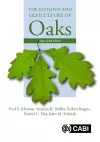
Ecology and Silviculture of Oaks, The
5 authors - Hardback
£172.99
Paul S. Johnson is a retired research forester who began his professional career as an instructor at Michigan State University. He subsequently joined the U.S Forest Service, Northern Research Station, in Columbia, Missouri, where he worked for more than 30 years. He has been the creator and driving force behind the first and subsequent editions of The Ecology and Silviculture of Oaks. Paul is an accomplished photographer, historian and essayist. He has employed those skills to author other books on other topics including: Where Pelicans Fly--A Celebration of the Extraordinary Everyday (ISBN-13: 978-1479309580). Chequamegon: A Dispatch from Northern Wisconsin (ISBN-13: 978-1077886896). A Place Called Chequamegon (ASIN: ?B0CB7MCPXZ). Stephen Shifley is a retired research forester who for 41 years worked for the Northern Research Station of the U.S. Forest Service. His major research topics included modelling growth and yield of hardwood forests, quantifying forest stand dynamics, modelling landscape-scale patterns of forest change in response to disturbance, quantifying structure and composition of old-growth forests in the Midwest U.S., and quantifying regional indicators of forest sustainability. He has published more than 150 scientific and technical manuscripts. Beginning in 2000, he has coauthored the first three editions of The Ecology and Silviculture of Oaks. Robert (Bob) Rogers is a retired professor of forestry at the University of Wisconsin-Stevens Point where he spent more than 30 years educating the next generation of forest managers. In the 1990s he and Paul Johnson developed the initial concept and outline for a project that eventually became the first edition of the Ecology and Silviculture of Oaks. Bob's areas of expertise include how soil-site relationships affect forest development and the application of quantitative methods to manage forests Daniel C. Dey is an award-winning scientist and Assistant Director for Research at the U.S. Forest Service Northern Research Station. His research evaluates silvicultural practices to manage forests that produce the wide array of goods and services. He specializes in solving forest regeneration issues in hardwood-dominated forests in both uplands and bottomlands. He has done extensive work with collaborators on determining historic fire regimes in oak/pine-dominated ecosystems throughout the Eastern U.S. This knowledge is the basis for developing management guidelines that combine prescribed fire with thinning and harvesting to restore native forest communities, including woodlands and savannas. He has authored more than 250 scientific and technical publications dealing with these topics, including work in North America, South America and Europe. John Kabrick is the unit leader of the U.S. Forest Service research group of the Northern Research Station headquartered in Columbia, Missouri. He is the recipient of prestigious national and regional awards for his work. John has academic degrees in both soil science and forestry, and he teaches a graduate-level course on forest soils. His current research includes management of mixed-woods, with particular emphasis on forests that are mixtures of oaks and pines. He also studies carbon dynamics in hardwood and mixed-wood forests with emphasis on understanding the implications for carbon storage and climate change. Additionally, John investigates the effects of prescribed fire and other management practices on the restoration and maintenance of oak savannahs and woodlands.